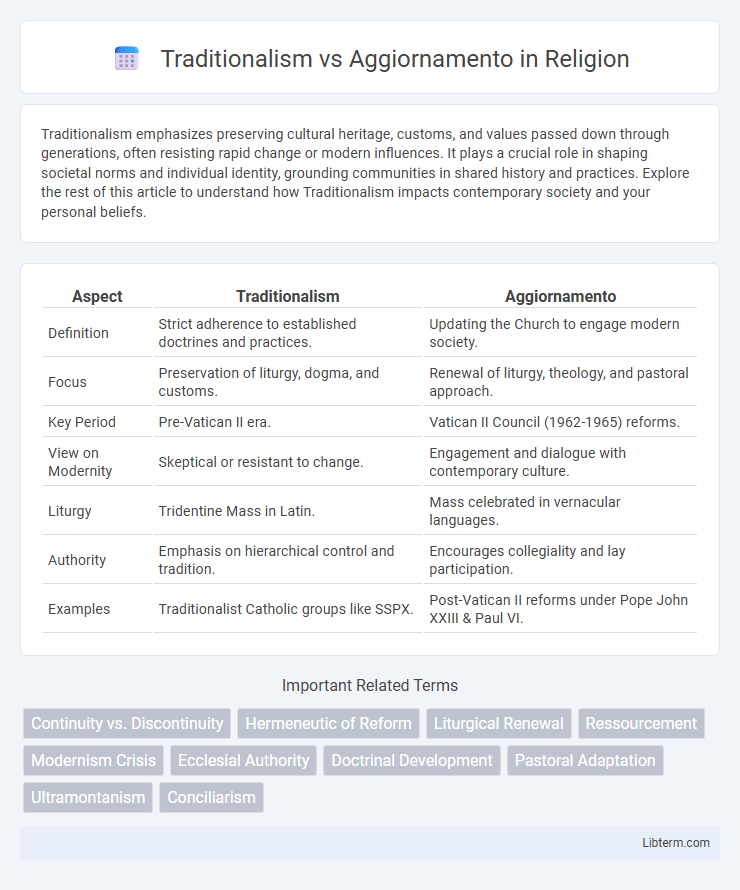Traditionalism emphasizes preserving cultural heritage, customs, and values passed down through generations, often resisting rapid change or modern influences. It plays a crucial role in shaping societal norms and individual identity, grounding communities in shared history and practices. Explore the rest of this article to understand how Traditionalism impacts contemporary society and your personal beliefs.
Table of Comparison
| Aspect | Traditionalism | Aggiornamento |
|---|---|---|
| Definition | Strict adherence to established doctrines and practices. | Updating the Church to engage modern society. |
| Focus | Preservation of liturgy, dogma, and customs. | Renewal of liturgy, theology, and pastoral approach. |
| Key Period | Pre-Vatican II era. | Vatican II Council (1962-1965) reforms. |
| View on Modernity | Skeptical or resistant to change. | Engagement and dialogue with contemporary culture. |
| Liturgy | Tridentine Mass in Latin. | Mass celebrated in vernacular languages. |
| Authority | Emphasis on hierarchical control and tradition. | Encourages collegiality and lay participation. |
| Examples | Traditionalist Catholic groups like SSPX. | Post-Vatican II reforms under Pope John XXIII & Paul VI. |
Defining Traditionalism and Aggiornamento
Traditionalism emphasizes preserving established doctrines, liturgical practices, and hierarchical structures within religious or cultural contexts, often resisting modern changes to maintain continuity and orthodoxy. Aggiornamento advocates for updating and renewing traditions by adapting to contemporary societal values, encouraging reform and dialogue to make institutions more relevant and accessible. The debate between Traditionalism and Aggiornamento centers on balancing respect for historical foundations with the need for progress and modernization.
Historical Origins of the Debate
The debate between Traditionalism and Aggiornamento originated during the Second Vatican Council (1962-1965), where Church leaders confronted the challenge of preserving doctrinal continuity while responding to modern societal changes. Traditionalism emphasizes adherence to established liturgical practices and theological interpretations rooted in centuries-old Church teachings. Aggiornamento, championed by Pope John XXIII, advocates for the renewal and adaptation of Church rituals and doctrines to engage contemporary culture and address current pastoral needs.
Philosophical Underpinnings of Traditionalism
Traditionalism in philosophy emphasizes the unchanging nature of universal truths rooted in historical religious and cultural doctrines, advocating for the preservation of established values and practices. It asserts that moral and metaphysical realities are fixed and accessible through tradition and authoritative teachings, resisting modern reinterpretations or innovations. This worldview fundamentally contrasts with aggiornamento, which supports adaptation and renewal to address contemporary challenges while maintaining core principles.
The Emergence and Meaning of Aggiornamento
Aggiornamento emerged during the Second Vatican Council as a progressive movement aimed at modernizing the Catholic Church by updating its practices and doctrines to engage with contemporary society. This concept contrasted sharply with Traditionalism, which emphasized preserving established rituals, dogmas, and the Latin liturgy without alteration. Aggiornamento represented a conscious effort to renew the Church's relevance through aggiornamento--meaning "bringing up to date"--by fostering dialogue, liturgical reforms, and a more pastoral approach.
Key Figures in Traditionalism and Aggiornamento
Key figures in Traditionalism include Pope Pius X, who emphasized strict adherence to established doctrine and liturgy, and Cardinal Alfredo Ottaviani, known for his defense of conservative theology during Vatican II. In Aggiornamento, Pope John XXIII stands out for initiating the Council to modernize Church practices, alongside theologians like Yves Congar and Joseph Ratzinger, who advocated for renewal and engagement with contemporary society. These leaders shaped the contrasting approaches of maintaining tradition versus embracing reform within the Catholic Church.
Case Studies: Tradition vs. Renewal in Practice
Case studies of Traditionalism vs Aggiornamento reveal contrasts in religious institutions balancing continuity and reform, such as Vatican II's liturgical changes versus conservative parishes upholding Latin Mass traditions. In politics, Japan's post-war constitutional reforms exemplify aggiornamento promoting democratic values, while factions resist change to preserve imperial customs. These practical examples demonstrate tensions between preserving established norms and embracing renewal to address modern challenges.
Impact on Religious Customs and Practices
Traditionalism in religion emphasizes preserving established rituals, doctrines, and liturgical forms, reinforcing continuity and stability within faith communities. Aggiornamento advocates for modernizing religious customs and practices to align with contemporary cultural contexts, often resulting in revised liturgies, inclusive language, and updated pastoral approaches. The tension between these perspectives profoundly influences worship styles, devotional expressions, and community engagement, shaping the evolving identity of religious institutions.
Social and Cultural Consequences
Traditionalism in religion emphasizes preserving established doctrines and rituals, fostering cultural continuity and social cohesion within communities by reinforcing identity and stability. Aggiornamento, meaning "bringing up to date," encourages adaptation to modern contexts, promoting social progress and cultural inclusivity but sometimes causing friction with conservative values. The tension between these approaches shapes societal debates on moral norms, education, and intergenerational values, influencing broader cultural transformations.
Contemporary Challenges and Perspectives
Traditionalism in the Catholic Church emphasizes preserving established doctrines and rituals, often resisting modern reforms to maintain historical continuity. Aggiornamento, promoted during the Second Vatican Council, seeks to update Church practices to engage effectively with contemporary society and address new ethical, cultural, and technological challenges. Navigating these perspectives requires balancing respect for theological traditions with openness to progressive changes that respond to evolving spiritual and societal needs.
Balancing Tradition and Modernization
Balancing tradition and modernization involves integrating the core values and rituals of Traditionalism with the progressive reforms championed by Aggiornamento. This dynamic tension requires maintaining respect for historical doctrines while embracing necessary updates to engage contemporary society effectively. Successful balance ensures continuity of identity alongside adaptability to evolving cultural and technological contexts.
Traditionalism Infographic

 libterm.com
libterm.com